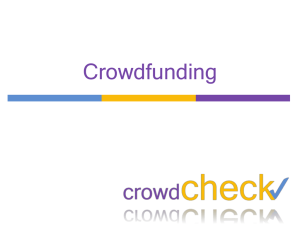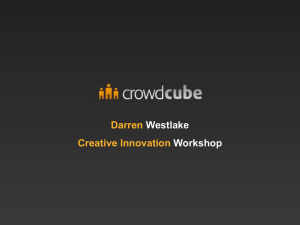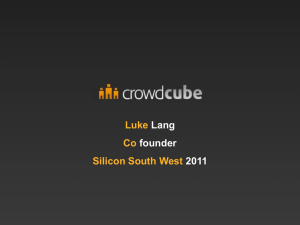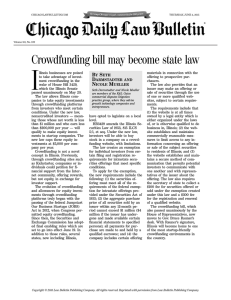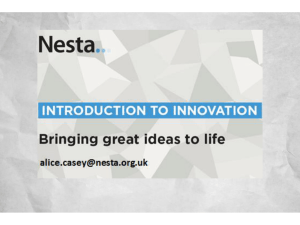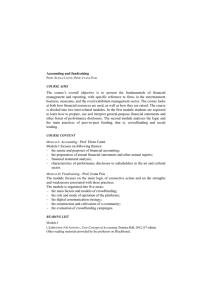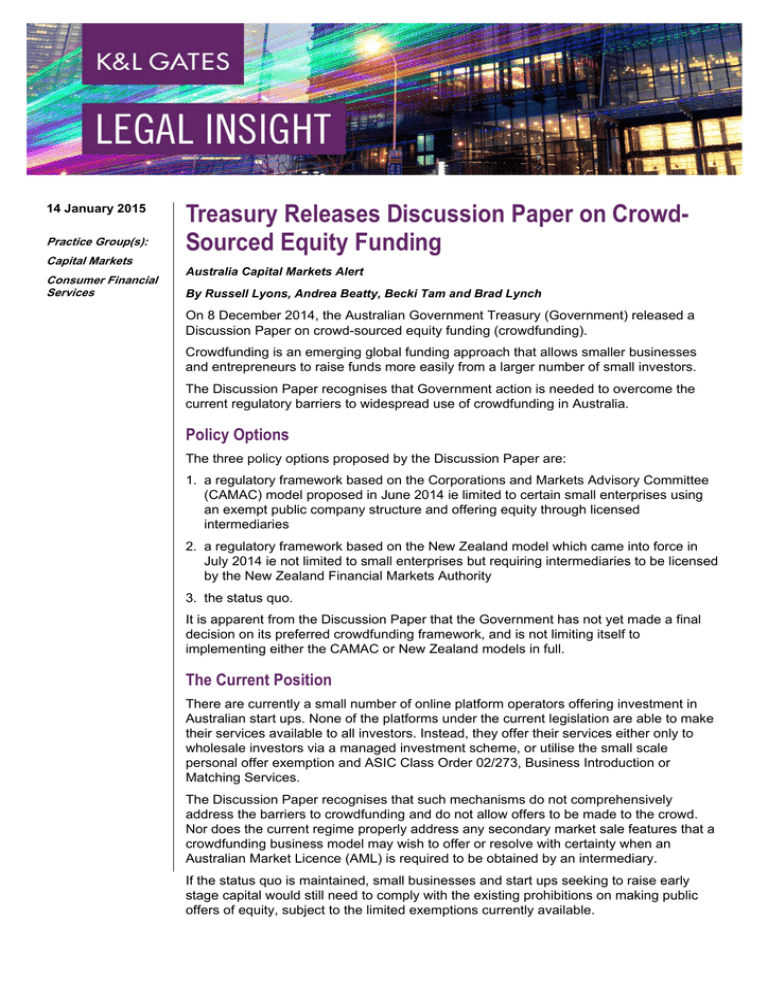
14 January 2015
Practice Group(s):
Capital Markets
Consumer Financial
Services
Treasury Releases Discussion Paper on CrowdSourced Equity Funding
Australia Capital Markets Alert
By Russell Lyons, Andrea Beatty, Becki Tam and Brad Lynch
On 8 December 2014, the Australian Government Treasury (Government) released a
Discussion Paper on crowd-sourced equity funding (crowdfunding).
Crowdfunding is an emerging global funding approach that allows smaller businesses
and entrepreneurs to raise funds more easily from a larger number of small investors.
The Discussion Paper recognises that Government action is needed to overcome the
current regulatory barriers to widespread use of crowdfunding in Australia.
Policy Options
The three policy options proposed by the Discussion Paper are:
1. a regulatory framework based on the Corporations and Markets Advisory Committee
(CAMAC) model proposed in June 2014 ie limited to certain small enterprises using
an exempt public company structure and offering equity through licensed
intermediaries
2. a regulatory framework based on the New Zealand model which came into force in
July 2014 ie not limited to small enterprises but requiring intermediaries to be licensed
by the New Zealand Financial Markets Authority
3. the status quo.
It is apparent from the Discussion Paper that the Government has not yet made a final
decision on its preferred crowdfunding framework, and is not limiting itself to
implementing either the CAMAC or New Zealand models in full.
The Current Position
There are currently a small number of online platform operators offering investment in
Australian start ups. None of the platforms under the current legislation are able to make
their services available to all investors. Instead, they offer their services either only to
wholesale investors via a managed investment scheme, or utilise the small scale
personal offer exemption and ASIC Class Order 02/273, Business Introduction or
Matching Services.
The Discussion Paper recognises that such mechanisms do not comprehensively
address the barriers to crowdfunding and do not allow offers to be made to the crowd.
Nor does the current regime properly address any secondary market sale features that a
crowdfunding business model may wish to offer or resolve with certainty when an
Australian Market Licence (AML) is required to be obtained by an intermediary.
If the status quo is maintained, small businesses and start ups seeking to raise early
stage capital would still need to comply with the existing prohibitions on making public
offers of equity, subject to the limited exemptions currently available.
Treasury Releases Discussion Paper on Crowd-Sourced Equity Funding
Currently, intermediaries are subject to a number of requirements, including:
the need to hold an Australian Financial Services Licence (AFSL) and comply with
AFSL licensing obligations if they meet the definition of carrying on a financial
services business
the need to hold an AML and comply with AML licensing obligations if they fall within
the definition of conducting a financial market
if a managed investment scheme (MIS) structure is used to facilitate an online equity
offer, the need for the intermediary to comply with MIS requirements, including having
a responsible entity that is a public company with disclosure and compliance
obligations.
Key Elements of the CAMAC and New Zealand Models
The Discussion Paper contains a useful summary comparing a number of the key
elements of the CAMAC and New Zealand models. Of particular note:
Issuer Cap – Both models impose a cap for issuers of raising AUD2 million via
crowdfunding in any 12 month period, excluding funds raised under existing
prospectus exemptions for wholesale investors.
Intermediary Remuneration – Under the CAMAC model intermediaries are
prohibited from being remunerated according to the amount of funds raised by the
issuer, or in the securities or other interest of the issuer. Under the New Zealand
model there are no restrictions on fee structures, although fees paid by an issuer must
be disclosed. The Discussion Paper suggests that a potential benefit of the New
Zealand model may be the ability for an intermediary to charge a fee proportional to
the funds raised. This is consistent with market practice for other equity capital
raisings and provides an incentive for intermediaries to only list issuers they consider
will successfully raise funds.
Issuer Corporate Form – CAMAC's models involves the creation of a new category
of public company which may add complexity to the corporate governance framework.
The Discussion Paper seeks comment on whether the proposed corporate form may
increase risks of regulatory arbitrage compared to the status quo, and whether these
risks outweigh the benefits of the structure in facilitating crowdfunding.
Investor Caps and Disclosure – The New Zealand model only imposes minimum
disclosure requirements and investment caps for investors are voluntary. The CAMAC
model sets mandatory caps and template disclosure requirements which may provide
greater certainty around the level of disclosure required.
Licensing Requirements – Both models impose licensing requirements and require
limited due diligence checks on the issuer.
Compliance Costs
Interestingly, the Discussion Paper includes estimates of compliance costs for issuers
and intermediaries associated with implementing either the CAMAC or the New Zealand
model.
The Discussion Paper suggests that compliance costs for intermediaries are expected to
increase per fundraising campaign under both models, with a marginal saving for an
intermediary if operating under the CAMAC model.
2
Treasury Releases Discussion Paper on Crowd-Sourced Equity Funding
For an issuer, the Discussion Paper assesses that there will be significantly larger cost
savings under the CAMAC model, driven largely by temporary exemptions from audit and
annual general meeting requirements and reductions in disclosure costs.
Consultation
The Discussion Paper requests stakeholder feedback by 6 February 2015. Views are
sought from a range of stakeholders, including intermediaries that offer equity and reward
based crowdfunding platforms, investors in the venture capital sector, the small business
sector and other government agencies.
Should the Government proceed with legislation to facilitate crowdfunding, it will seek to
conduct further consultations on any draft legislative package to ensure the appropriate
balance between reducing regulatory barriers and maintaining adequate investor
protections.
Future of Crowdfunding
Exactly how the regulatory environment will change remains in a state of flux. There is
substantial uncertainty surrounding the future direction of legislative change for regulating
crowdfunding as well as other innovative forms of financing that have captured the
attention of regulators, such as peer to peer lending and the growth of secondary market
sales of 'crowd' acquired equity interests.
The Financial System Inquiry Final Report (Final Report) was released on 7 December
2014. The Inquiry recommends that the Government should graduate fundraising
regulation to facilitate securities based crowdfunding and consider more holistic
regulatory settings to facilitate internet based financing. The Treasurer has called for
consultation on the Final Report. Submissions are to be made before 31 March 2015,
prior to any decisions made by the Government on the recommendations in the Final
Report.
Various business models are emerging under the current Australian status quo and in the
New Zealand market. However, all of these are still in their infancy and the financial and
industry data available is limited to fully assess the benefits and risks for issuers and
investors alike.
Equity crowdfunding is an emerging practice across global markets. It will not replace the
many other forms of capital raising and investment structures for companies seeking to
grow and build a wider shareholder base, but it may assist with the start up and
incubation of new Australian businesses. However, legislative and regulatory certainty
surrounding the issues involved in crowdfunding is a pre-requisite to a confident
Australian and Trans-Tasman business community that truly fosters innovation and
entrepreneurship.
Contact Us
Please contact us if you need any assistance in preparing a submission or would like
further information on this topic, equity capital raisings, venture capital, licensing or
regulatory matters.
3
Treasury Releases Discussion Paper on Crowd-Sourced Equity Funding
Authors:
Russell Lyons
Andrea Beatty
russell.lyons@klgates.com
+61.2.9513.2510
andrea.beatty@klgates.com
+61.2.9513.2333
Becki Tam
Brad Lynch
becki.tam@klgates.com
+61.2.9513.2514
brad.lynch@klgates.com
+61.7.3233.1264
Anchorage Austin Beijing Berlin Boston Brisbane Brussels Charleston Charlotte Chicago Dallas Doha Dubai Fort Worth Frankfurt
Harrisburg Hong Kong Houston London Los Angeles Melbourne Miami Milan Moscow Newark New York Orange County Palo Alto
Paris Perth Pittsburgh Portland Raleigh Research Triangle Park San Francisco São Paulo Seattle Seoul Shanghai Singapore
Spokane Sydney Taipei Tokyo Warsaw Washington, D.C. Wilmington
K&L Gates comprises more than 2,000 lawyers globally who practice in fully integrated offices located on five
continents. The firm represents leading multinational corporations, growth and middle-market companies,
capital markets participants and entrepreneurs in every major industry group as well as public sector entities,
educational institutions, philanthropic organizations and individuals. For more information about K&L Gates or
its locations, practices and registrations, visit www.klgates.com.
This publication is for informational purposes and does not contain or convey legal advice. The information herein should not be used or relied upon
in regard to any particular facts or circumstances without first consulting a lawyer.
© 2014 K&L Gates LLP. All Rights Reserved.
4

